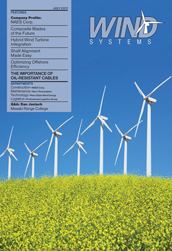The rail belt stretches from the south in Seward all the way north to Fairbanks, Alaska’s second-largest city in the center of the state. The remote communities—otherwise known as “villages,” which are situated along the rail belt corridor—are able to tap into the existing power infrastructure for electric service to power individual residences and public facilities. The Southwest Alaska community of Kokhanok, like most villages in the state, is a beautiful and remote settlement of just under 200 people located on the south side of Lake Iliamna, within the Lake and Peninsula Borough. Kokhanok is not in close proximity to the rail belt, and villages such as these that are completely off the grid must maintain their own infrastructure for power generation. The challenge involved finding a realistic way to make this happen.
Centralized Power Generation
Because electricity in remote Alaskan villages usually costs six to eight times more than it does in villages along the rail belt, the State of Alaska tasked the Alaska Energy Authority with implementing the PCE (Power Cost Equalization) program to assist remote communities with meeting their power generation needs. In its literature the authority writes that “PCE fundamentally improves Alaska’s standard of living by helping small rural areas maintain the availability of communications and the operation of basic infrastructure and systems, including water and sewer, incinerators, heat and light. PCE is a core element underlying the financial viability of centralized power generation in rural communities.” Figure 1
In order to assist residential village customers in offsetting costs, the PCE program requires communities to provide monthly and annual reporting to remain in compliance with state regulations. Kokhanok’s village utility clerks were diligent and accurate in their reporting, so in an effort to ensure uniform and regular payment schedules “Ampy” prepay meters were installed in residences to ensure collections. These units also assisted community members in learning how to conserve energy and lower their individual usage. The Ampy meters eliminated disconnect and reconnect fees, allowed those customers with overdue balances to restore their service with PCE, and provided the utility with consistent collections.
Luckily, the village’s power plant already possessed properly sized and loaded diesel gensets, and the utility’s operating procedures demonstrated a history of consistent documented maintenance practices that maximized their fuel savings. This standard of excellence set the stage for a wind-diesel hybrid project, which can only succeed with a well-maintained diesel plant and a well-managed electric utility.
Integrated Energy
The village electric utility currently operates a diesel power plant with a total installed capacity rating of 490 kW with a peak operating load of approximately 110 kW. The Lake and Peninsula Borough (LPB) considered their ever-present wind as a viable source for alternative energy. The subsequent Alaska Energy Authority study of 2006 showed that Kokhanok has a Class 6 wind resource with negligible turbulence, no adverse avian issues, and no other permitting problems.
Transporting diesel fuel from Anchorage or Seattle to the village of Kokhanok is an expensive logistical challenge. Fuel must be barged to the village, preferably up the Kvichak River. When that route is unavailable due to low water levels, fuel must be traversed from Anchorage or Seattle to Williams Port, transferred to trucks and driven over the mountains, then transferred to a barge for shipment across Lake Iliamna for delivery to Kokhanok. When the fuel barge could not navigate the Kvichak River in the fall of 2008, fuel had to be flown into the community at $7.20 per gallon for an entire year. In 2008 the Kokhanok Electric Utility was forced to charge residents $.90/kWh for power in order to cover their cost to produce power. Figure 2
In July of 2009 the village and the LBP committed to integrate wind energy with diesel power to provide a local renewable low-cost energy resource for the community. Marsh Creek, LLC, was awarded the engineering, procurement, and construction contract on July 11, 2009, for a high penetration wind-diesel system with coincident thermal energy production; the first of its kind in Alaska. “High penetration” means that diesel generators may be shut down during high wind availability, that auxiliary components are required to regulate voltage and frequency, and that a sophisticated control system is required. Peak instantaneous penetration is 100-400 percent, while the annual average is 50-150 percent.
“Kokhanok Village, as with many villages, faces uncertain times when it comes to the future of electrical power production and heating due to high fuel prices,” according to Nathan Hill, village administrator. “Installing a high penetration wind-diesel system will help us stabilize these costs, thus making village life as we know it more sustainable. We are looking forward to working with Marsh Creek as we build capacity to operate our new system and of course reap the benefits of a more predictable and sustainable source of energy.”
Offsetting Traditional Sources
Construction began on the $1.94-million project in May 2010 and was completed on time and on budget in October 2010. Included in the project were two reconditioned Vestas V-17 turbines rated at 90kW each on 85’ lattice towers with 56’ rotors, and 180 kW of connected wind capacity. The 1991 turbines were remanufactured by Halus Power Systems in 2010.
A synchronous condenser and grid forming inverter were installed, along with 336 kWh of nominal battery storage. As of February 2011, the refurbished Vestas wind turbines were fully operational, as they remain today. Figure 3
The system stores excess energy to the battery bank for use during non-wind times. Additionally, the excess electricity from the wind turbines heats up water and feeds it to the existing jacket water heat recovery system and into the local school’s recirculation system. The hybrid system is expected to displace half of the village’s previous annual fuel consumption.
The Hybrid Wind Turbine Integration Project also included a substantial power plant controls upgrade, a remote operations monitoring and control system, and wind system operator training. The advanced supervisory control and data acquisition (SCADA) system allows engineers in Anchorage to view wind turbine production and to manipulate the parameters of the controls via a computer connection. The SCADA system monitors and gathers information and relays it back to the central site in Anchorage. It displays information in a clear and logical fashion and creates an instant alert if there is a problem. Remote monitoring, and the ability to manipulate the system operations from Anchorage, provides the community’s local operators with a measure of confidence in their ability to manage the system with advice from engineers available at a moment’s notice. It also saves travel expenses, making the project possible.
This unique hybrid system, with an installed wind capacity of 180 kW, has the potential to offset the traditional diesel power plant production by 19,297 gallons of fuel, or 51 percent, potentially saving the village over $110,000 in fuel costs annually.
“We normally burn upwards of 141 gallons of fuel in a 24 hour period,” says John Mike, power plant operator. “When the wind is blowing and the turbines are operating, we only burn about 70 gallons, or half the amount of fuel we usually do. When the computer controls are fully operational this coming July the system will be completely automatic, making our lives a lot easier.”
Villagers and project team members attended the ribbon cutting ceremony in October of 2010 to celebrate their new wind turbines. Village Elders Francine Andrew and Annie Mike were two who took advantage of the beautiful day to mark the occasion. Figure 4
On March 10, 2011, the Kokhanok Hybrid Wind Turbine Integration Project was awarded “Most Innovative Project” at the 2011 International Wind-Diesel Workshop in Girdwood, Alaska. The workshop was designed to bring the wind-diesel community together to share the status of current technology, discuss applications that work and those that do not, and to shed light on areas for improvement. Following the workshop, approximately 17 attendees boarded planes and flew from Girdwood to Kokhanok for an on-site tour of the wind turbines. Commissioning activities were completed shortly thereafter.
Project Summary
With this successful project completed on time and on budget, Marsh Creek will enter into a five-year maintenance and training agreement with the village, which is a key element in the program. This long-term commitment of training, operation, and maintenance between the village and Marsh Creek will ensure continuity of maintenance provided by professionals, and it is a critical component for both parties. The agreement will also ensure that the village remains current on training with Marsh Creek’s professional staff.







































